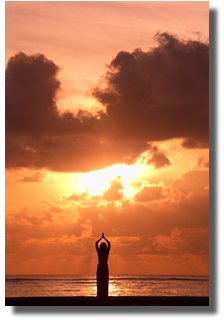Imagine this: you return from your vacation renewed and refreshed, like you really had some time off. At work, you have a stronger sense of purpose, a feeling of authenticity that permeates all of your professional relationships. At home, you are more the person you want to be: strong, energetic and aware. It sounds like you just returned from a retreat at a center specializing in meditation and body soothing yoga. Think clean air, 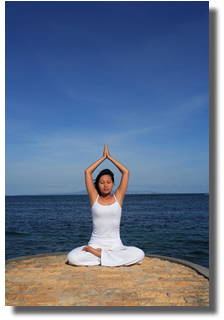 good simple food, no clutter, no telephones… and time to unwind and get reacquainted with yourself and loved ones. Far from being a “new age” junket, yoga retreats are a way to reconnect with the simple process of being. When all goes as planned, you not only return home feeling on top of the world – as though you really have had a holiday – you will return with knowledge on how to maintain your newly centered feeling when back in the hustle and bustle of your everyday life.
good simple food, no clutter, no telephones… and time to unwind and get reacquainted with yourself and loved ones. Far from being a “new age” junket, yoga retreats are a way to reconnect with the simple process of being. When all goes as planned, you not only return home feeling on top of the world – as though you really have had a holiday – you will return with knowledge on how to maintain your newly centered feeling when back in the hustle and bustle of your everyday life.
Breathe slowly and deeply and relax into the thought of blissful peace and tranquility. Forget the mass market cruises, the theme parks and the mad rush of too much in too little time. A meditation retreat does not mean that you HAVE to go to India, or sit unmoving in a cold cave at the top of a remote mountain. Meditation, yoga, taiji, and similar mind/body experiences, encompassing anything from spiritual to philosophical, are available in almost every corner of the world from Buddhist retreats in Africa to yoga centers in Taiwan and Zendos in Switzerland. While this article focuses on yoga, many of the same opportunities exist for combining travel and other body/mind disciplines.
With a few structured searches through your favorite yoga magazine and a visit to your travel agent, you will be able to plan your own relaxing trip to the retreat of your choice and combine a wonderful vacation with the study of a relaxing, spiritual discipline – long before your incense stick has burned all the way down.
Choosing a Retreat
There is a mind-boggling array of retreat options from which to choose. As always, the best place to start is a careful consideration of your interests and the destinations that coincide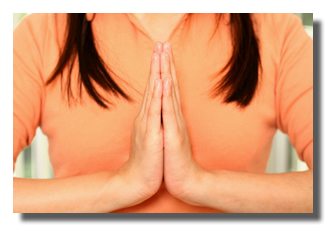 with your interests. If you already have a particular yoga style that you follow or you know of a teacher or instructor with whom you would like to study, you have successfully narrowed your choices! If, however, you are open to a variety of options, there are yoga retreats in hundreds of locations and venues: castles, beaches, ashrams and city parks. You can choose tropical locations in Hawaii, practice yoga in the Alps or salute the sun in a monastery in California. Because yoga is so widely practiced and because every village, hamlet, town and city has a multitude of schools and styles available, it is not an exaggeration to say that anywhere you desire to visit, there you will find an opportunity to practice yoga with a teacher.
with your interests. If you already have a particular yoga style that you follow or you know of a teacher or instructor with whom you would like to study, you have successfully narrowed your choices! If, however, you are open to a variety of options, there are yoga retreats in hundreds of locations and venues: castles, beaches, ashrams and city parks. You can choose tropical locations in Hawaii, practice yoga in the Alps or salute the sun in a monastery in California. Because yoga is so widely practiced and because every village, hamlet, town and city has a multitude of schools and styles available, it is not an exaggeration to say that anywhere you desire to visit, there you will find an opportunity to practice yoga with a teacher.
The more interesting challenge will be to determine whether you are looking for a resort type of experience or a deeper, more intensive experience. Most resorts provide some opportunity for yoga practice, some with informal classes and others with more formal instruction. The resort experience typically ensures that you will stay limber and toned while enjoying a more traditional vacation experience. Resorts offer flexibility and chance to practice while vacationing with others who may be non-practitioners.
Yoga retreats and ashrams, on the other hand, focus on yoga as the reason for attending. At a yoga retreat, you are immersed in the world of yoga: new positions, philosophies, styles and practices. Those around you are practitioners and your instructors are advance adepts. Your time is structured, your meals planned, your activities centered on yoga practice. You experience yoga as part of a community in a sanctuary of like-minded individuals.
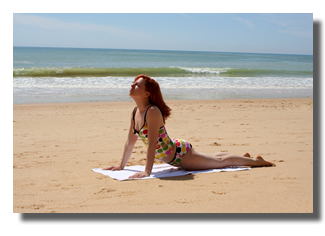 When choosing your own yoga vacation experience, find a point on the spectrum of opportunities with which you and any traveling companions will be comfortable. Will everyone in your group be happy with your choice? Do you want to commit to hours of practice each day or would a class in the morning followed by your own choice of activities be more to your liking? Do you want a structured environment? How much of each day is given over to actual practice and how much to other activities? Is the yoga style one with which you are comfortable? Inquire about daily routines. Do participants rise at dawn or are classes available on a regular schedule throughout the day. When are meals? Are there opportunities for non-scheduled activities or is the routine regimented? In general, what are the ambiance and the rhythm of the retreat you have under consideration?
When choosing your own yoga vacation experience, find a point on the spectrum of opportunities with which you and any traveling companions will be comfortable. Will everyone in your group be happy with your choice? Do you want to commit to hours of practice each day or would a class in the morning followed by your own choice of activities be more to your liking? Do you want a structured environment? How much of each day is given over to actual practice and how much to other activities? Is the yoga style one with which you are comfortable? Inquire about daily routines. Do participants rise at dawn or are classes available on a regular schedule throughout the day. When are meals? Are there opportunities for non-scheduled activities or is the routine regimented? In general, what are the ambiance and the rhythm of the retreat you have under consideration?
When evaluating a range of possible retreats, consider the demographics of the retreat’s typical client. Does the retreat host a range of yoga practitioner skills, or does it focus on the novice or advanced practitioner? What is the age range and gender of a typical client? Finding yourself out of your skill level or mixed with others with whom you have little in common will likely result in disappointment. Also, inquire about the number of students that will be present during your visit. Too small a group results in little interaction with a variety of people while too many students means less interaction with instructors.
Accommodations and facilities vary widely from yoga retreat to retreat. Some have very luxurious and soothing environments while others provide a very Spartan appointment. Many yoga resorts are also spas, providing a host of amenities and services such as exercise rooms, weights, saunas and massage. Others are quiet centers for meditation and reflection. Again, your personal preferences and the goals you have set for yourself will dictate your choice. What is important is to be well informed prior to making your selections and deposits!
Diet and food are often very important aspects of a yoga retreat’s amenities. Again, inquire with regard to the dietary philosophies and food preparations during your planning stages. Most will provide a range of foods and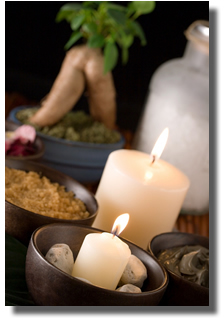 diets, from vegetarian to full cuisine, from raw food diets and all manner of specialty culinary experiences in between. Make sure that your own goals match closely the dietary offerings of the center you will be visiting. Note too that most facilities on the more intensive side of the spectrum do not allow caffeine or alcohol and may restrict other substances as well. A week or more of a highly specialized diet can either be a blessing or a burden, so choose with care.
diets, from vegetarian to full cuisine, from raw food diets and all manner of specialty culinary experiences in between. Make sure that your own goals match closely the dietary offerings of the center you will be visiting. Note too that most facilities on the more intensive side of the spectrum do not allow caffeine or alcohol and may restrict other substances as well. A week or more of a highly specialized diet can either be a blessing or a burden, so choose with care.
In providing your travel arrangements, travel agents can access a large array of travel options and discounts not available to the public at large. Travel agents work with tour operators that package air travel, accommodations and land transportations at large discounts from the retail purchase of those same components. Thus, a travel agent is a great place to go with assistance in your travel arrangements regardless of your choice of destination for your yoga retreat. Your travel costs and opportunities, as well as the climate of your preference may have a lot to do with the season during which you choose to visit your yoga center. Ask your travel consultant to price both peak and off-peak travel seasons to provide you with some insight into the range of travel opportunities available to you.
The Experience
Although your experience will vary from country to country and among the various styles of yoga retreats, there are a number of common denominators to most yoga retreat experiences. Expect simple and clean accommodation – nothing cluttered or fancy, and little high tech – think Zen simplicity with no television, radio or intrusive telephone – and no room service. Nevertheless, visiting retreats and ashrams is typically a very comfortable, enriching experience and in retreats in general have attempted in recent years to make themselves much more accessible to travelers.
If attending a more disciplined, intensive retreat, your room is likely to contain a bed, a table, a chair – and perhaps a single picture or vase of flowers and not much more, apart from a fan for summer and a heater and extra blankets for winter. Some rooms might have a kettle and a facility to make tea or coffee.
You are likely to be woken by an early morning gong around sun rise – although whether you get up to participate in early morning mediations or exercises is usually entirely of your own volition. In fact participation in all events is quietly encouraged, but never monitored or enforced – it’s usually voluntary.
 Most meditation centers have a period or noble silence (sometimes referred to, tongue in cheek, as “no bull” silence) generally from the last teaching in the evening to after breakfast the following morning. It is often challenging to maintain but provides a quiet time to observe both yourself and others – and to learn to drop your inhibitions and communicate on a different level. (“Pass the salt, please” takes on a whole new meaning and teaches you to appreciate things you take for granted).
Most meditation centers have a period or noble silence (sometimes referred to, tongue in cheek, as “no bull” silence) generally from the last teaching in the evening to after breakfast the following morning. It is often challenging to maintain but provides a quiet time to observe both yourself and others – and to learn to drop your inhibitions and communicate on a different level. (“Pass the salt, please” takes on a whole new meaning and teaches you to appreciate things you take for granted).
Three full healthy meals are usually provided. They are generally simple vegetarian meals and what one would consider quiet and claming foods, often homegrown and homemade, and the quantities are plentiful.
You are likely to find an area for meditation, benches out in the open to sit in contemplation and one or several pieces of central focus like a stupa, or large statue, as well as zen sand gardens and possibly even a labyrinth around which you can stretch your legs and mind,
Most centers will supply cushions or stools for seated mediation and mats or other necessary items for yoga or the training you have chosen. There is usually a shop selling incense, small statues, cards, CDs, memorabilia and accessories. They often also have a range of natural soaps and oils and cotton clothing and beautiful shawls as well.
If you’ve not done this sort of thing before, do expect to be stretched – if not (ever so gently) in a physical manner with controlled yoga or flowing taiji exercises, then mentally as your perceptions of reality are questioned – often through silence, sometimes through very simple, but revealing exercises.
On one retreat attended by this author, we were told that the instructor was delayed and that we would all be assigned tasks in the garden for a few hours. Although nobody stood up and complained, we all went through an array of emotions that started with outraged indignation, moved to annoyance and had us muttering under our breath amongst ourselves, and finally to acceptance and the realization that working in the garden (being in the now), was enjoyable… and just as we were beginning to enjoy our work we were told to stop and discuss our feelings. A valuable lesson all round.
What to take
Pack suitable clothing for the season within the country you are visiting. For this type of retreat, with a concentration of healthy and natural living, try to choose cotton clothing (it does crease, but It’s not synthetic and it is more comfortable on the skin) that is loose and does not restrict your movements (if doing yoga or taiji) or your circulation (if sitting still, meditating). Bring an extra warm layer, just in case so that you will be at a comfortable temperature during meditation.
Light color clothing is recommended both because it is less attractive insects and because it does not block the flow of energy and is said to make you more open and receptive to new ideas.
Walking shoes are a good idea. There are usually some beautiful walks through the centre grounds. Bring a note book to jot down thoughts, ideas and observations and almost as equally indispensable is insect repellant – but try to find a natural product rather than chemical one.
Depending on the retreat center you will probably find a flashlight useful for walking between buildings at night and a small daypack is useful for packing or storing a jacket, bottle of water (and keeping your room keys safe), and will probably save you several unnecessary trips back to your room to collect something.
Most centers have a library with related books that is open to visitors to the centre. Try to leave work-related books at home, along with your normal reading material, and open yourself up to a new experience through the available books.
Your introductory materials to the retreat will most likely provide you with a list of recommended clothing and gear. Other than that – all that is needed is a mind open to new experiences.
Final considerations
Budget for making a donation (often called dhana) to the center and/or the teachers. Most centers charge cost related rates and do not focus on profit – as such, donations go a long way to maintaining and improving the centre. Likewise many of the teachers visiting teachers teach for the love of it, without remuneration, and most of the resident teachers receive a small monthly stipend, so again donations to teachers in appreciation of knowledge and understanding shared is always appreciated. Dhana is not expected, but affords you the opportunity to return some loving kindness if it feels right to you.
If you are contemplating some serious training – albeit in yoga, taiji or mediation – do some practice to get into shape both mentally and physically. Some basic stretching, conditioning and toning for yoga, leg strength and taiji training for taiji and some sitting practice for meditation.
Now pack your mat and hit the road. Namaste


